Copernican Revolution
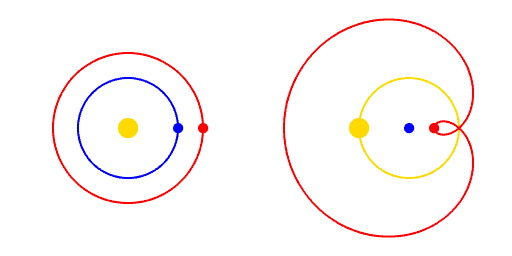
(To create a smooth animation, Mars' period of revolution is depicted as exactly 2 years instead of 1.88. The orbits are depicted as circular in the heliocentric case.)
The Copernican Revolution was the paradigm shift from the Ptolemaic model of the heavens, which described the cosmos as having Earth stationary at the center of the universe, to the heliocentric model with the Sun at the center of the Solar System. Beginning with the publication of Nicolaus Copernicus’s De revolutionibus orbium coelestium, contributions to the “revolution” continued until finally ending with Isaac Newton’s work over a century later.
Heliocentrism
Before Copernicus
The "Copernican Revolution" is named for Nicolaus Copernicus, whose Commentariolus, written before 1514, was the first explicit presentation of the heliocentric model in Renaissance scholarship. The idea of heliocentrism is much older; it can be traced to Aristarchus of Samos, a Hellenistic author writing in the 3rd century BC, who may in turn have been drawing on even older concepts in Pythagoreanism. Ancient heliocentrism was, however, eclipsed by the geocentric model presented by Ptolemy and accepted in Aristotelianism.
European scholars were well aware of the problems with Ptolemaic astronomy since the 13th century. The debate was precipitated by the reception by Averroes' criticism of Ptolemy, and it was again revived by the recovery of Ptolemy's text and its translation into Latin in the mid-15th century.[lower-alpha 1] Otto E. Neugebauer in 1957 argued that the debate in 15th-century Latin scholarship must also have been informed by the criticism of Ptolemy produced after Averroes, by the Ilkhanid-era (13th to 14th centuries) Persian school of astronomy associated with the Maragheh observatory (especially the works of Al-Urdi, Al-Tusi and Ibn al-Shatir).[2]
The state of the question as received by Copernicus is summarized in the Theoricae novae planetarum by Georg von Peuerbach, compiled from lecture notes by Peuerbach's student Regiomontanus in 1454 but printed only in 1472. Peuerbach attempts to give a new, mathematically more elegant presentation of Ptolemy's system, but he does not arrive at heliocentrism. Regiomontanus himself was the teacher of Domenico Maria Novara da Ferrara, who was in turn the teacher of Copernicus.
There is a possibility that Regiomontanus already arrived at a theory of heliocentrism before his death in 1476, as he paid particular attention to the heliocentric theory of Aristarchus in a late work, and mentions the "motion of the Earth" in a letter.[3]
Nicolaus Copernicus
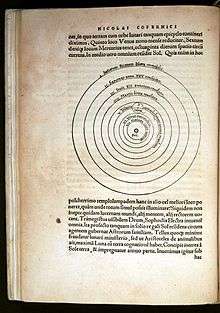
Copernicus studied at Bologna University during 1496–1501, where he became the assistant of Domenico Maria Novara da Ferrara. He is known to have studied the Epitome in Almagestum Ptolemei by Peuerbach and Regiomontanus (printed in Venice in 1496) and to have performed observations of lunar motions on 9 March 1497. Copernicus went on to develop an explicitly heliocentric model of planetary motion, at first written in his short work Commentariolus some time before 1514, circulated in a limited number of copies among his acquaintances. He continued to refine his system until publishing his larger work, De revolutionibus orbium coelestium (1543), which contained detailed diagrams and tables.[4]
The Copernican model makes the claim of describing the physical reality of the cosmos, something which the Ptolemaic model was no longer believed to be able to provide. Copernicus removed Earth from the center of the universe, set the heavenly bodies in rotation around the Sun, and introduced Earth's daily rotation on its axis.[4] While Copernicus's work sparked the "Copernican Revolution", it did not mark its end. In fact, Copernicus's own system had multiple shortcomings that would have to be amended by later astronomers.
Reception
Tycho Brahe
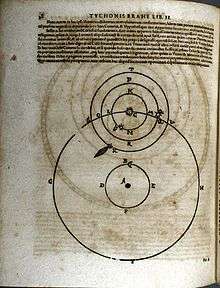
Tycho Brahe (1546–1601) was a Danish nobleman who was well known as an astronomer in his time. Further advancement in the understanding of the cosmos would require new, more accurate observations than those that Nicolaus Copernicus relied on and Tycho made great strides in this area. Tycho Brahe accepted Copernicus's model but reasserted geocentricity.
In 1572, Tycho Brahe observed a new star in the constellation Cassiopeia. For eighteen months, it shone brightly in the sky with no visible parallax, indicating it was part of the heavenly region of stars according to Aristotle's model. However, according to that model, no change could take place in the heavens so Tycho’s observation was a major discredit to Aristotle’s theories. In 1577, Tycho observed a great comet in the sky. Based on his parallax observations, the comet passed through the region of the planets. According to Aristotelian theory, only uniform circular motion on solid spheres existed in this region, making it impossible for a comet to enter this region. Tycho concluded there were no such spheres, raising the question of what kept a planet in orbit.[5]
With the patronage of the King of Denmark, Tycho Brahe established Uraniborg, an observatory in Hven.[6] For 20 years, Tycho and his team of astronomers compiled astronomical observations that were vastly more accurate than those made before. These observations would prove vital in future astronomical breakthroughs.
Tycho also formulated his own astronomical system, claiming it to be superior to those of Ptolemy and Copernicus. Although Tycho appreciated the advantages of Copernicus's system, he could not accept the movement of the Earth and settled on geoheliocentrism, meaning the Sun moved around the Earth while the planets orbited the Sun.[5]
Johannes Kepler
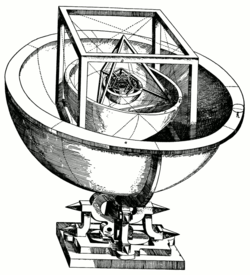
Kepler found employment as an assistant to Tycho Brahe and, upon Brahe's unexpected death, replaced him as imperial mathematician of Emperor Rudolph II. He was then able to use Brahe's extensive observations to make remarkable breakthroughs in astronomy, such as the three laws of planetary motion. Kepler would not have been able to produce his laws without the observations of Tycho, because they allowed Kepler to prove that planets traveled in ellipses, and that the Sun does not sit directly in the center of an orbit but at a focus. Galileo Galilei came after Kepler and developed his own telescope with enough magnification to allow him to study Venus and discover that it has phases like a moon. The discovery of the phases of Venus was one of the more influential reasons for the transition from geocentrism to heliocentrism.[7] Sir Isaac Newton's Philosophiæ Naturalis Principia Mathematica concluded the Copernican Revolution. The development of his laws of planetary motion and universal gravitation explained the presumed motion related to the heavens by asserting a gravitational force of attraction between two objects.[8]
In 1596, Kepler published his first book, the Mysterium Cosmographicum, which was the first to openly endorse Copernican cosmology by an astronomer since 1540.[5] The book described his model that used Pythagorean mathematics and the five Platonic solids to explain the number of planets, their proportions, and their order. The book garnered enough respect from Tycho Brahe to invite Kepler to Prague and serve as his assistant.
In 1600, Kepler set to work on the orbit of Mars, the second most eccentric of the six planets known at that time. This work was the basis of his next book, the Astronomia nova, which he published in 1609. The book argued heliocentrism and ellipses for planetary orbits instead of circles modified by epicycles. This book contains the first two of his eponymous three laws of planetary motion. In 1619, Kepler published his third and final law which showed the relationship between two planets instead of single planet movement.
Kepler's work in astronomy was new in part. Unlike those who came before him, he discarded the assumption that planets moved in uniform circular motion, replacing it with elliptical motion. Also, like Copernicus, he asserted the physical reality of a heliocentric model as opposed to a geocentric one. Yet, despite all of his breakthroughs, Kepler could not explain the physics that would keep a planet in its elliptical orbit.
Kepler's laws of planetary motion
- 1. The Law of Ellipses: All planets move in elliptical orbits, with the Sun at one focus.
- 2. The Law of Equal Areas in Equal Time: A line that connects a planet to the Sun sweeps out equal areas in equal times.
- 3. The Law of Harmony: The time required for a planet to orbit the Sun, called its period, is proportional to long axis of the ellipse raised to the 3/2 power. The constant of proportionality is the same for all the planets.
Galileo Galilei
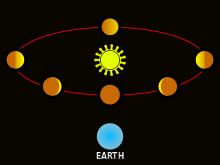
Galileo Galilei was an Italian scientist who is sometimes referred to as the "father of modern observational astronomy".[9] His improvements to the telescope, astronomical observations, and support for Copernicanism were all integral to the Copernican Revolution.
Based on the designs of Hans Lippershey, Galileo designed his own telescope which, in the following year, he had improved to 30x magnification.[10] Using this new instrument, Galileo made a number of astronomical observations which he published in the Sidereus Nuncius in 1610. In this book, he described the surface of the Moon as rough, uneven, and imperfect. He also noted that "the boundary dividing the bright from the dark part does not form a uniformly oval line, as would happen in a perfectly spherical solid, but is marked by an uneven, rough, and very sinuous line, as the figure shows."[11] These observations challenged Aristotle's claim that the moon was a perfect sphere and the larger idea that the heavens were perfect and unchanging.
Galileo's next astronomical discovery would prove to be a surprising one. While observing Jupiter over the course of several days, he noticed four stars close to Jupiter whose positions were changing in a way that would be impossible if they were fixed stars. After much observation, he concluded these four stars were orbiting the planet Jupiter and were in fact moons, not stars.[12] This was a radical discovery because, according to Aristotelian cosmology, all heavenly bodies revolve around the Earth and a planet with moons obviously contradicted that popular belief.[13] While contradicting Aristotelian belief, it supported Copernican cosmology which stated that Earth is a planet like all others.[14]
In 1610, Galileo observed that Venus had a full set of phases, similar to the phases of the moon we can observe from Earth. This was explainable by the Copernican system which said that all phases of Venus would be visible due to the nature of its orbit around the Sun, unlike the Ptolemaic system which stated only some of Venus's phases would be visible. Due to Galileo's observations of Venus, Ptolemy's system became highly suspect and the majority of leading astronomers subsequently converted to various heliocentric models, making his discovery one of the most influential in the transition from geocentrism to heliocentrism.[7]
Sphere of the fixed stars
In the sixteenth century, a number of writers inspired by Copernicus, such as Thomas Digges, Giordano Bruno and William Gilbert argued for an indefinitely extended or even infinite universe, with other stars as distant suns. This contrasts with the Aristotelian view of a sphere of the fixed stars. Although opposed by Copernicus and Kepler (with Galileo not expressing a view), by the middle of the 17th century this became widely accepted, partly due to the support of René Descartes.
Chinese astronomy
The Chinese astronomical tradition has often been viewed as largely contrasting that of the European astronomical tradition as is in much of the scholarship that shows many of the modern scientific ideas are traced back directly to independent European discoveries. For example, in the opening of his book From the Closed World to the Infinite Universe, Alexandre Koyré maintains that “the conception of the infinity of the universe, like everything else or nearly everything else, originates, of course, with the Greeks.”[15] French scholar Hélène Metzger’s Histoire des Sciences overviews “what is known about life and work of each of the characters who have left a trace in science.”[16] Metzger only stresses the contributions from people like Pierre Bayen, Jacques Rohault, Antoine Lavoisier, Pierre-Sylvain Régis, Émile Picard, Jean-Jacques d'Ortous de Mairan, Louis Bertrand Castel, César-François Cassini de Thury, Isaac Newton, and René Descartes. They are all European and Metzger maintains that it wasn't until their works that interest in science began.[17] Thomas Kuhn’s The Structure of Scientific Revolutions, which was extremely influential in the history and philosophy of scientific knowledge, closely follows the same narrative being that Kuhn heavily studied the writings of Koyré and Metzger as they were particularly influential “in shaping [his] conception of what the history of scientific ideas can be.”[18] Kuhn’s scholarship maintains the view that “only civilizations that descend from Hellenic Greece have possessed more than the most rudimentary science” and that the majority of scientific progress comes from Europe, for which no other community could have encouraged such endeavors.[19] However, by the European Renaissance in the 16th century, both of the Chinese and the Islamic civilizations had reached a level of scientific knowledge that surpassed the West most notably in natural science. They both used experimentation to get scientific results long before the European Renaissance and used an intricate mathematical language to describe their findings.[20] By ignoring the role of the many multi-cultural influences on scientific progress and assuming Khun’s, Koyré’s, or Metzger’s point of view, what’s left is purely a narrow eurocentric history of the birth of modern science, which can be grossly misleading.
But further scholarship concerning the birth of modern science by people like Joseph Needham with influential works such as Science and Civilisation in China, Justin Lin in “The Needham Puzzle”, and Dr. Arun Bala in The Dialogue of Civilizations in the Birth of Modern Science that recognize and include the multicultural impact ignored by earlier scholars that allow for a wider and more inclusive view of the Copernican Revolution, one that is not limited to Europe alone. Although some scholars criticize Needham as overemphasizing Chinese scientific advancements, Needham's research was some of the first to recognize Chinese contributions to the scientific world, which led the way for other scholars like Lin and Bala.[21]
Bala describes the earliest model of the many highly sophisticated Chinese astronomical theories emerged in the first century. The gai tian astronomical tradition theorized the sky as forming a dome or canopy around the earth, which provided an explanation for day and night, and as the cause of seasonal variation.[22] The following hun tian theory that also developed in the first century by Zhang Heng (78-139) elaborated further on the earlier Chinese astronomical model as “The heavens are like a hen’s egg; the earth is like the yolk of the egg, and lies alone in the center.”[23] In this model of the world, as is often thought of today, the hun tian tradition theorizes the earth as a celestial sphere. This idea allowed Zhang to develop a celestial grid mapping system, for which more accurate star maps could be drawn.[24] This new mapping system would later be discovered by Europeans in 1568 called mercator projection that could make a cylindrical map flat by copying projections of constellations onto a transparent globe.[25]
Chinese astronomical theories further developed as early as the 4th century. Chinese philosopher Ge Hong (Ko Hung, 283-342), who compiled doctrines from various schools of thought, theorized of a universe that is infinite “having no bounds.”[26] The most sophisticated xuan ye theory was adopted by the neo-Confucian orthodoxy, and widely accepted by Chinese astronomers long before re-opened communications by Europe with a new corridor into China in 1514.[27]
Bala then writes how these Chinese astronomical theories along with many other sophisticated models were widely circulated back in Europe.[28] After 1514, Jesuit missionary astronomers flooded into China eager to learn and understand Chinese astronomical ideas. They frequently communicated some of these ideas back to Europe in letters.[29] The Jesuit astronomer and mathematician Matteo Ricci regularly wrote back home to Europe in the 16th century, relaying a number of Chinese astronomical ideas, models, and theories.[30] Many of the ideas Ricci circulated back to Europe would later become adopted into modern astronomy; some examples were: there is only one sky, not ten skies which Ricci believed, that stars float in an infinite void space, that an envelope of air encompassed the earth, that the moon impedes the light from the sun in an eclipse, and the sun falls below the horizon at night.[31] The Chinese also believed that celestial bodies formed from the condensation of vapors they called qi, which align very close to modern theories that stars and the solar system formed from the condensation of gas, and opposed European theories of the 16th century that the heavens were unable to change over time that lasted into the 18th century.[32] Chinese astronomical ideas were considered controversial by Europeans and heavily investigated where as the scientific ideas that would later develop in Europe closely related to early Chinese astronomical ideas in the 16th century.[33]
However Ricci believed in geocentrism and is in another source described as "astonished at how hard it was for his "students" to accept the vision of a universe made up of crystalline spheres with the heavens and the earth rigidly separate,"[34] and in another source as offering a map that is "divided into eight panels, it includes a drawing of the nine concentric spheres of the universe as conceived by Ptolemy, plus two. Ricci added two spheres[...]'The ‘First Movable’ and the sphere where God, the angels and the blessed live.'"[35] Because of this he didn't even seem to subscribe to the ideas of Copernicus, let alone those of his own contemporaries. Ricci also describes his audience as not knowing what air is, so they characterize it as a void instead.[36]
Arabic Astronomy
In the Arabic-Islamic world, primarily the 10th and 11th centuries, was considered a resourceful era in Islamic science. [37] Thus leading Copernicus a better understanding of the Ptolemaic model. Muslim scholars such as Ibn al-Haytham, al-Shatir, al-Tusi, al-Urdi contributed to the development of astronomy. Ibn al-Haytham put forward a planetary motion idea questioning and doubted Ptolemy's model. By the 11th and 12th century, Al-Haytham work reached Spain and Asia.[38] Ibn al-Shatir created similar models to Copernicus away from the Ptolemaic model. Which evidently led to a new research for Islam. [39]Arabic mathematicians unable to make Ptolemaic astronomy connect to Aristotelian cosmology modified the Ptolemaic system, and heavily criticized its tradition. Medieval European astronomers inherited Arabic attempts at mathematical realism in the Ptolemaic system that created a new line of scientific motivation, which influenced the direction of Copernicus’s work.[40] Without a doubt, the contributions that the Arabic-Islamic civilization made to help the development of modern science before the 13th century are significant by "its contributions to the fund of knowledge, logical, mathematical, and [the] methodological."[41] However, there is a counter-argument to all of the scientific achievements of the Arabic-Islamic civilization. The prevailing notion is that the lack of societal "freedom of thought and expression" inhibited Arabic-Islamic science from advancing any further, and eventually led to its decline in the 15th century.[42] This conclusion is often perceived only because of characterizations from misunderstandings in the subtle differences practiced in Arab/Muslim groups throughout the world which leads to the reinforcing of Orientalism when considering Arabic-Islamic scientific achievements.[43]
Maragha Observatory
An institution that was specialized in astronomy, the Maragha observatory in Iran.[44] Ibn al-Tusi was apart of the observatory and provided a better insight of the Ptolemy's faulty model. Maraghan predecessors were able to configure a fragmented heliocentric model.[45] Nasir al-Din al-Tusi (1201-1274) spent much of his time addressing problems with Ptolemy's model that resulted in the first non-Ptolemaic model for the moon at the Maragha school observatory.[46] Copernicus can be seen in the shadows of the Maragha school. They both shared strong ideas of astronomy that questions the connection between the school findings and Copernicus discovery.[47]
Tusi Couple
Ibn al-Tusi was able to illustrate a model that would represent the motion of planets. This model was created in the 13th century.[48] Copernicus applied this method to his own model. Evidently he made the model more "complicated".[49] Not only that but, Copernicus uses the Alphabetic letters as Tusi does.[50]
Arabic Mathematics
Mohammed ibn Musa al-Khowarizimi, developed Algebra and his work would help develop European algebra. Arabic algebra conversion expanded Copernicus understanding to mathematics.[51]
Isaac Newton
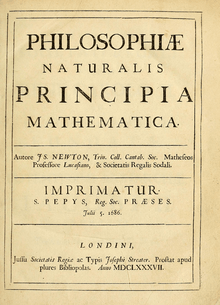
Newton was a well known English physicist and mathematician who was known for his book Philosophiæ Naturalis Principia Mathematica.[52] He was a main figure in the Scientific Revolution for his laws of motion and universal gravitation. The laws of Newton are said to be the ending point of the Copernican Revolution.
Newton used Kepler's laws of planetary motion to derive his law of universal gravitation. Newton's law of universal gravitation was the first law he developed and proposed in his book Principia. The law states that any two objects exert a gravitational force of attraction on each other. The magnitude of the force is proportional to the product of the gravitational masses of the objects, and inversely proportional to the square of the distance between them.[8] Along with Newton's law of universal gravitation, the Principia also presents his three laws of motion. These three laws explain inertia, acceleration, action and reaction when a net force is applied to an object.
Immanuel Kant
Immanuel Kant in his Critique of Pure Reason (1787 edition) drew a parallel between the "Copernican revolution" and the epistemology of his new transcendental philosophy.[53] Kant's comparison is made in the Preface to the second edition of the Critique of Pure Reason (published in 1787; a heavy revision of the first edition of 1781). Kant argues that, just as Copernicus moved from the supposition of heavenly bodies revolving around a stationary spectator to a moving spectator, so metaphysics, "proceeding precisely on the lines of Copernicus' primary hypothesis", should move from assuming that "knowledge must conform to objects" to the supposition that "objects must conform to our [a priori] knowledge".[lower-alpha 2]
Much has been said on what Kant meant by referring to his philosophy as "proceeding precisely on the lines of Copernicus' primary hypothesis". There has been a long-standing discussion on the appropriateness of Kant’s analogy because, as most commentators see it, Kant inverted Copernicus' primary move.[55] According to Tom Rockmore,[56] Kant himself never used the "Copernican revolution" phrase about himself, though it was "routinely" applied to his work by others.
Metaphorical usage
Following Kant, the phrase "Copernican Revolution" in the 20th century came to be been used for any (supposed) paradigm shift, for example in reference to Freudian psychoanalysis[57] or postmodern critical theory.[58]
See also
Notes
- ↑ "Averroes' criticism of Ptolemaic astronomy precipitated this debate in Europe. [...] The recovery of Ptolemy's texts and their translation from Greek into Latin in the middle of the fifteenth century stimulated further consideration of these issues."[1]
- ↑ In an English translation: "Hitherto it has been assumed that all our knowledge must conform to objects. But all attempts to extend our knowledge of objects by establishing something in regard to them a priori, by means of concepts, have, on this assumption, ended in failure. We must therefore make trial whether we may not have more success in the tasks of metaphysics, if we suppose that objects must conform to our knowledge. This would agree better with what is desired, namely, that it should be possible to have knowledge of objects a priori, determining something in regard to them prior to their being given. We should then be proceeding precisely on the lines of Copernicus' primary hypothesis. Failing of satisfactory progress in explaining the movements of the heavenly bodies on the supposition that they all revolved round the spectator, he tried whether he might not have better success if he made the spectator to revolve and the stars to remain at rest. A similar experiment can be tried in metaphysics, as regards the intuition of objects."[54]
References
- ↑ Osler (2010), p. 42
- ↑ George Saliba (1979). "The First Non-Ptolemaic Astronomy at the Maraghah School", Isis 70 (4), pp. 571–576.
- ↑ Arthur Koestler, The Sleepwalkers, Penguin Books, 1959, p. 212.
- 1 2 Osler (2010), p. 44
- 1 2 3 Osler (2010), p. 53
- ↑ J J O'Connor and E F Robertson. Tycho Brahe biography. April 2003. Retrieved 2008-09-28
- 1 2 Thoren (1989), p. 8
- 1 2 Newton, Isaac (1999). The Principia: Mathematical Principles of Natural Philosophy. Translated by I. Bernard Cohen; Anne Whitman; Julia Budenz. Berkeley: University of California Press. ISBN 0-520-08817-4.
- ↑ Singer (1941), p. 217
- ↑ Drake (1990), pp. 133-134
- ↑ Galileo, Helden (1989), p. 40
- ↑ Drake (1978), p. 152
- ↑ Drake (1978), p. 157
- ↑ Osler (2010), p. 63
- ↑ Koyré, Alexandre (2008). From the closed world to the infinite universe. Charleston, SC: Forgotten Books. p. 7. ISBN 978-1-6062-0143-5. OCLC 794964344.
- ↑ Metzger, Hélène (1932). "Histoire des Sciences". Revue Philosophique de la France et de l'Étranger. 114: 145 – via JSTOR.
- ↑ Metzger (1932), Histoire des Sciences, pg. 143-49.
- ↑ Kuhn, Thomas S. (1970). The structure of scientific revolutions. Chicago: University of Chicago Press. p. vi. ISBN 0226458032. OCLC 93075.
- ↑ Kuhn (1970), The Structure of Scientific Revolutions, pg. 168
- ↑ Sabila, George (Autumn 1999). "Seeking the Origins of Modern Science?". Bulletin of the Royal Institute for Inter-Faith Studies (BRIIFS). 1, 2.
- ↑ Lin, Justin Yifu (1995). "The Needham Puzzle: Why the Industrial Revolution Did Not Originate in China". Economic Development and Cultural Change. 43 (2): 287.
- ↑ Bala (2006), p. 135.
- ↑ Bala (2006), p. 135.
- ↑ Bala (2006), p. 135.
- ↑ Bala (2006), p. 135.
- ↑ Bala (2006), p. 136.
- ↑ Bala (2006), pp. 136-139.
- ↑ Bala (2006), p. 141.
- ↑ Bala (2006), p. 132.
- ↑ Bala (2006), p. 132.
- ↑ Bala (2006), pp. 132-133.
- ↑ Bala (2006), p. 138.
- ↑ Bala (2006), p. 138.
- ↑ Fontana, Michela (2011). Matteo Ricci a Jesuit in the Ming Court. Lanham: Rowman & Littlefield Pub. Group. p. 164. ISBN 1442205881.
- ↑ Melvin, Sheila (September 27, 2010). "Missionary to the Forbidden City". NY Times. Retrieved 4 August 2018.
- ↑ Bala (2006), p. 132.
- ↑ Sabra, A. I. (September 1987). "The Appropriation and Subsequent Naturalization of Greek Science in Medieval Islam: A Preliminary Statement". History of Science. 25 (3): 223–243. doi:10.1177/007327538702500301. ISSN 0073-2753.
- ↑ Sabra, A. I. (December 1985). ""The Andalusian Revolt against Ptolemaic Astronomy" in Transformation and Tradition in the Sciences: Essays in Honor of I. Bernard Cohen. Everett Mendelsohn". The Quarterly Review of Biology. 6: 134. doi:10.1086/414574. ISSN 0033-5770.
- ↑ Saliba, George (December 1979). "The First Non-Ptolemaic Astronomy at the Maraghah School". Isis. 70 (4): 571–576. doi:10.1086/352344. ISSN 0021-1753.
- ↑ Bala (2006), p. 148.
- ↑ Huff, Toby E. (2017). The Rise of Early Modern Science. Cambridge: Cambridge University Press. p. 15. doi:10.1017/9781316417805. ISBN 9781316417805.
- ↑ Huff, Toby E. (Autumn–Winter 2002). "The Rise of Early Modern Science: A Reply to George Sabila". Bulletin of the Royal Institute of Inter-Faith Studies (BRIIFS). 4 (2).
- ↑ Sabila, George (Autumn–Winter 2002). "Flying Goats and Other Obsessions: A Response to Toby Huff's "Reply"". Bulletin of the Royal Institute for Inter-Faith Studies (BRIIFS). 4 (2).
- ↑ Needham, Joseph (1954–2004). "Science and Civilization in China. [New York: Cambridge University Press, 1954]". The Social Background. doi:10.1017/s030574100004011x. ISSN 0305-7410.
- ↑ Huff, Toby E. "9 – The rise of early modern science". The Rise of Early Modern Science: Islam, China and the West. Cambridge University Press. pp. 325–361. doi:10.1017/cbo9781316257098.013. ISBN 978-1-3162-5709-8.
- ↑ Saliba, George (1979). "The First Non-Ptolemaic Astronomy at the Maraghah School". Isis. 70 (4): 571. doi:10.1086/352344. ISSN 0021-1753.
- ↑ Saliba, George (July 1987). "The Rôle of Maragha in the Development of Islamic Astronomy : A scientific revolution before the renaissance". Revue de synthèse. 108 (3–4): 361–373. doi:10.1007/bf03189067. ISSN 0035-1776.
- ↑ Saliba, George. "A History of Arabic Astronomy | Planetary Theories During the Golden Age of Islam | Books - NYU Press | NYU Press". nyupress.org.
- ↑ Saliba, George (1987). "Mathematical Astronomy in Copernicus's De Revolutionibus. (Book Review)". Renaissance Quarterly. 40: 109–112.
- ↑ Saliba, George (2002). "Flying Goats and Other Obsessions: A Response to Toby Huff's "Reply"". riifs.org.
- ↑ Boyer, Carl B. (1973). "Mathematics In The Time of Copernicus". The Polish Review. 18 (3): 25–30.
- ↑ See the Principia on line at Andrew Motte Translation
- ↑ Ermanno Bencivenga (1987), Kant's Copernican Revolution.
- ↑ Immanuel Kant (1929) [1787]. "Preface". Critique of Pure Reason. Translated by Norman Kemp Smith. Palgrave Macmillan. ISBN 1-4039-1194-0. Archived from the original on 2009-04-16.
- ↑ For an overview see Engel, M., Kant’s Copernican Analogy: A Re-examination, Kant-Studien, 54, 1963, p. 243. According to Victor Cousin: "Copernicus, seeing it was impossible to explain the motion of the heavenly bodies on the supposition that these bodies moved around the earth considered as an immovable centre, adopted the alternative, of supposing all to move round the sun. So Kant, instead of supposing man to move around objects, supposed on the contrary, that he himself was the centre, and that all moved round him." Cousin, Victor, The Philosophy of Kant. London: John Chapman, 1854, p. 21
- ↑ Tom Rockmore, Marx After Marxism: The Philosophy of Karl Marx (2002), p. 184.
- ↑ "By defining hysteria as an illness whose symptoms were produced by a person's unconscious ideas, Freud started what can be called a ‘Copernican Revolution’ in the understanding of mental illness — which put him into opposition both to the Parisian Charcot and to the German and Austrian scientific community." José Brunner, Freud and the Politics of Psychoanalysis (2001), p. 32.
- ↑ "Jacques Lacan's formulation that the unconscious, as it reveals itself in analytic phenomena, ‘is structured like a language’, can be seen as a Copernican revolution (of sorts), bringing together Freud and the insights of linguistic philosophers and theorists such as Roman Jakobson." Ben Highmore, Michel de Certeau: Analysing Culture (2006), p. 64.
Works cited
- Bala, Arun (2006). The Dialogue of Civilizations in the Birth of Modern Science. New York: Palgrave Macmillan. ISBN 978-0-230-60121-5. OCLC 191662056.
- Drake, Stillman (1978). Galileo At Work. Chicago: University of Chicago Press. ISBN 0-226-16226-5.
- Drake, Stillman (1990). Galileo: Pioneer Scientist. Toronto: The University of Toronto Press. ISBN 0-8020-2725-3.
- Galilei, Galileo (1989). Sidereus Nuncius. Albert Van Helden (trans.). Chicago, Illinois: University of Chicago Press. ISBN 9780226279039.
- Huff, Toby E. (2017). The Rise of Early Modern Science. Cambridge: Cambridge University Press. ISBN 9781316417805.
- Huff, Toby E. (Autumn–Winter 2002). "The Rise of Early Modern Science: A Reply to George Sabila". Bulletin of the Royal Institute of Inter-Faith Studies (BRIIFS). 4, 2.
- Kuhn, Thomas S. (1957). The Copernican Revolution: Planetary Astronomy in the Development of Western Thought. Cambridge, Massachusetts: Harvard University Press. ISBN 0-674-17103-9.
- Kuhn, Thomas S. (1970). The Structure of Scientific Revolutions. Chicago: Chicago University Press. ISBN 0226458032.
- Koyré, Alexandre (2008). From the Closed World to the Infinite Universe. Charleston, S.C.: Forgotten Books. ISBN 9781606201435.
- Lin, Justin Y. (1995). The Needham Puzzle: Why the Industrial Revolution Did Not Originate in China. Economic Development and Cultural Change, 43(2), 269-292. Retrieved from https://www.jstor.org/stable/1154499.
- Metzger, Hélène (1932). Histoire des sciences. Revue Philosophique De La France Et De L'Étranger, 114, 143-155. Retrieved from https://www.jstor.org/stable/41086443.
- Osler, Margaret (2010). Reconfiguring the World. Baltimore, Maryland: The Johns Hopkins University Press. p. 184. ISBN 0-8018-9656-8.
- Redd, Nola (May 2012). "Johannes Kepler Biography". Tech Media Network. Retrieved October 23, 2013.
- Saliba, George (1979). "The First Non-Ptolemaic Astronomy at the Maraghah School". Isis. 70 (4). ISSN 0021-1753.
- Sabila, George (Autumn 1999). "Seeking the Origins of Modern Science?". Bulletin of the Royal Institute for Inter-Faith Studies (BRIIFS). 1, 2.
- Sabila, George (Autumn–Winter 2002). "Flying Goats and Other Obsessions: A Response to Toby Huff's "Reply"". Bulletin of the Royal Institute for Inter-Faith Studies (BRIIFS). 4, 2.
- Singer, Charles (2007). A Short History of Science to the Nineteenth Century. Clarendon Press.
- Thoren, Victor E. (1989). Tycho Brahe. In Taton and Wilson (1989, pp. 3–21). ISBN 0-521-35158-8.
External links

